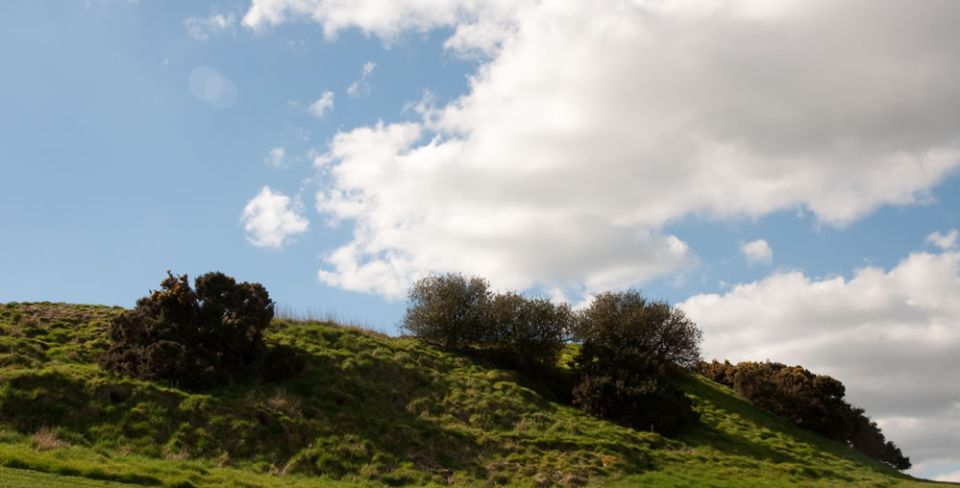5.1 Droim Ceat, Limavady
According to legend when Colmcille left Ireland it is said that he vowed never again to set foot on Irish soil. However he appears to have returned at least once – for the Convention of Drum Ceat probably in the 570s, here just south of Limavady.
The event is recorded by Colmcille’s biographer Adomnán and in the contemporary annals.
Greatly exaggerated – but fictional – accounts of the meeting were also recorded in later medieval literature, making it one of the most famous encounters in early Irish history.
For instance Manus O’Donnell’s Life of Colum Cille written in 1532 says that Colmcille used the meeting to argue that the poets of Ireland should not be expelled from the country for their ‘multitude, their sourness, their complaining and their wicked words’ and their impertinent behaviour towards King Áed mac Ainmirech. Other issues were allegedly discussed too.
However, the meeting was really about the political and military relationship between the king of the Dál Riata Áedán mac Gabráin who had land in the north of Ireland and the west of Scotland and the powerful northern Irish overking Áed mac Ainmirech from Donegal.
The meeting was held here, just south of Limavady, on a flat-topped mound from where there is a clear view in all directions. This land was in neutral territory close to the border between the two men’s territories.
Colmcille was a close kinsman of Áed but he was also the leading religious figure among the Dál Riata – the island of Iona was probably part of Dál Riata territory.
During his time in Ireland, Adomnán says that invalids were brought to Colmcille to be cured of illnesses.
‘Many sick people put their trust in him and received full healing, some from his outstretched hand, some from being sprinkled with water he had blessed, others by the mere touching of the edge of his cloak, or from something such as salt or bread blessed by the saint and dipped in water.’
Life of St Columba by Adomnán of Iona, Book II Story 6
O’Donnell’s Life Of Colum Cille claims that Colmcille attended Droim Ceat partly at the request of the men of Ireland:
‘that he might bless their laymen and clerics and their men and women before he left this life; for, at that time, he was at the end of his age and his span’.
Adomnán also says that Colmcille predicted the Battle of Dún Ceithirn during this visit.
North Sperrins and the Bann
- 5.1 Droim Ceat, Limavady
According to legend when Colmcille left Ireland it is said that he vowed never again to set foot on Irish soil. However he appears to have returned at least once - for the Convention of Drum Ceat probably in the 570s, here just south of Limavady. The event is recorded...
- 5.2 Giant’s Sconce
From the top of the Giant’s Sconce, it is easy to see why it would make a good place to build a fort. There are views in all directions and it is a short distance by land to the River Bann and the sea beyond. This monument is thought to...
- 5.3 St Patrick’s CofI, Coleraine
The earliest record of Coleraine appears in Adomnán’s Life of St Columba. Adomnán was an Abbot of Iona and wrote his account of Colmcille’s life a century after the saint’s death in 597. Adomnán mentions that Colmcille stayed with the Bishop of Coleraine on his way home from the Convention of Drum...
- 5.4 Camus
The red sandstone fragment of the early medieval Camus cross now stands in a graveyard on the west side of the River Bann to the south of Coleraine. The cross is carved with religious scenes on the front and back - the Ark and the murder of Abel on the...
- 5.5 Ballintemple
It is believed that the first church on this site was founded by St Adomnán (c.628-704), Abbot of the monastery at Iona from 679 to 704 and the author of the Life of St Columba. According to tradition, Adomnán wanted to build his church two miles away at Lisnascreaghog but every time the walls were...










Bòrd na Gàidhlig
Great Glen House
Leachkin Road
Inverness
Scotland, IV3 8NW
(+44) 01463 225454
colmcille@gaidhlig.scot
Colmcille
Foras na Gaeilge, 2-6 Queen Street
Belfast
Northern Ireland
BT1 6ED
(+44) 028 9089 0970
colmcille@forasnagaeilge.ie
Colmcille
Foras na Gaeilge, An Chrannóg
Na Doirí Beaga
Gaoth Dobhair
Donegal, Ireland. F92 EYT3
(+353) 074 9560113
colmcille@forasnagaeilge.ie


